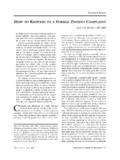Transcription of LONG-TERM CARE INSURANCE A LONG TERM …
1 Written By: Wayne Johnson, Tricia Matson and Margaret spencer Published In: IAIR - The INSURANCE Receiver P U B L I S H E D A R T I C L E S LONG-TERM care INSURANCE A long TERM PROBLEM By Wayne Johnson, Tricia Matson, Jan Moenck, and Andy Rarus The average life expectancy in the United States in 1970 was years, just over a one year increase from the average life expectancy in 1960 (1). It is against that backdrop that LONG-TERM care INSURANCE (LTCI) was originally conceived and marketed in the 1970 s. At the time the product was developed, interest rates were high and assumptions regarding investment income were made based upon the thought that interest rates would remain at high levels.
2 However, past performance is no guarantee of future results, and interest rates have been at historical lows since 2008. LTCI gained popularity in the late 1980 s and the early 1990 s, while at the same time the average life expectancy grew steadily and at rate that far outpaced the decade of the 1960 s. By 2013, the average life expectancy in the United States had ballooned to years. Today, financial planners continue to suggest LTCI as an essential element of a retirement plan. A closer look at LTCI beyond average life expectancy and interest rates reveals other stresses to the pricing of this product.
3 The frequency and severity of LTCI claims is increasing; a 2014 study performed by AON indicated that frequency was increasing 3% annually and severity was increasing 2% annually (2). The lapse rate for these policies has also been lower than expected. The same AON study showed that the overall loss ratio was expected to grow 5% annually. This perfect storm has caused LONG-TERM care INSURANCE to be a long term problem for insurers, regulators, and policyholders. According to an S&P Global Market Intelligence analysis of statutory filings, the insurers with the largest LTCI reserves at December 31, 2016 included the following chart (3): As can be seen on the chart, several insurers had significant adverse development in their reserves during 2016.
4 MetLife Inc., CNA Financial Corp., Unum Group and Prudential Financial, Inc. all stopped writing LTCI years ago, and Manulife Financial Corp. stopped writing these policies in 2016 (4). Genworth Financial Inc. continues to be a leader in writing LTCI, but realized that it will require additional capitalization to turn its business around and is in the midst of being acquired by a private investor to gain additional capitalization (5). Many of these insurers are actively working to file rate increases. In 2016, Northwestern Mutual initiated rate increases for the first time, obtaining approval for rate increases that would affect over 43,000 policyholders and result in approximately $23 million in calculated premium increases.
5 Genworth Financial Inc. is aggressively working to obtain rate increases, and the MetLife Inc. group of companies had the most filings approved in 2016, with 33 filings approved (6). There are only about 15 companies that continue to write LTCI (4). Many insurers have changed their product structure in efforts to return to profitability. One new product structure includes riders providing for accelerated benefits clauses on life INSURANCE products. The NAIC is also looking into new structures such as shorter duration products, annuity hybrid products, and the potential for favorable tax credit on LTCI savings accounts or purchases of LTCI from retirement plans (7).
6 P U B L I S H E D A R T I C L E S THE INSURANCE RECEIVER I SUMMER 2017 2 2 Although very well capitalized, and with a diversified book of products, Thrivent Financial for Lutherans poses another challenge. As a Fraternal, it is not covered by guaranty associations. In the very unlikely event it were to fail, it would need to either assess its members or the policyholders would suffer significant losses.
7 The Penn Treaty group of companies, which has recently had significant press with its insolvency, is not listed on the chart above. It is estimated to have a net liability of almost $ billion (7). The responsibility to provide funds for the benefits to the Penn Treaty policyholders now rests with the life and health INSURANCE guaranty associations. The Penn Treaty insolvency is having a major impact on life and health guaranty associations across the country, which have assessed their members to cover the cost of the insolvency.
8 As pointed out above, only a limited number of companies have written business in the LTCI market, leaving many companies that never wrote these types of policies with an assessment obligation to cover the cost. If another major insolvency of a LONG-TERM care insurer were to occur, it could have a devastating impact on the market. Given the risks present in the industry, the regulator is challenged with whether to limit rate increases to allow the policyholders to retain coverage at a reasonable price or to allow the increases to mitigate solvency issues.
9 Trends in rating practices Insurers have aggressive and specific targets for rate increases, often with a goal of 100% or lower lifetime loss ratio. To achieve this goal, double-digit rate increases have been common. These increases often have the potential for cross-block and cross-state subsidies, since some states approve only small increases and others approval much larger ones. There have also been offers of reduced benefits when rate increases have been high, in an effort to retain coverage for those who cannot afford such high rate increases.
10 Trends in reserving practices In an effort to reign in rate increases, insurers have taken measures such as including morbidity improvement assumptions in assessing reserve adequacy. They have also taken a more aggressive stance in including future non-approved rate increases and increases in investment income (based on a more illiquid or lower quality investment mix) in cash flow testing. Although in most cases state regulators have allowed some reflection of approved (but not implemented) rate increases, the amount by which regulators allow reflection of future non-approved rate increases varies greatly by state.





